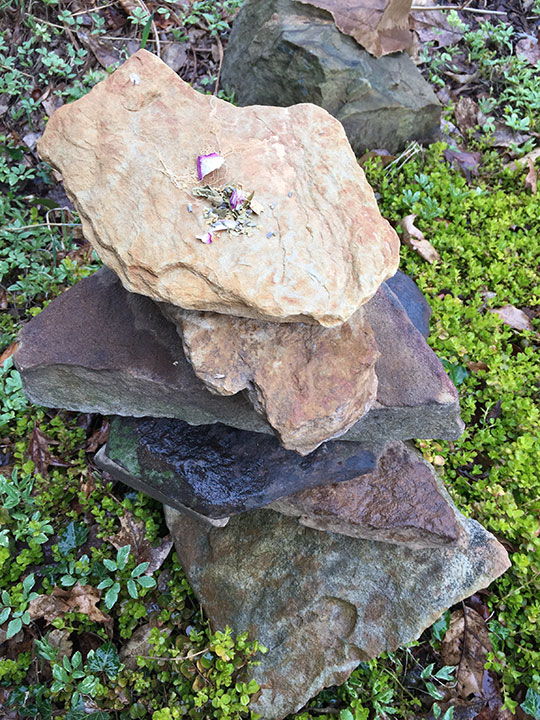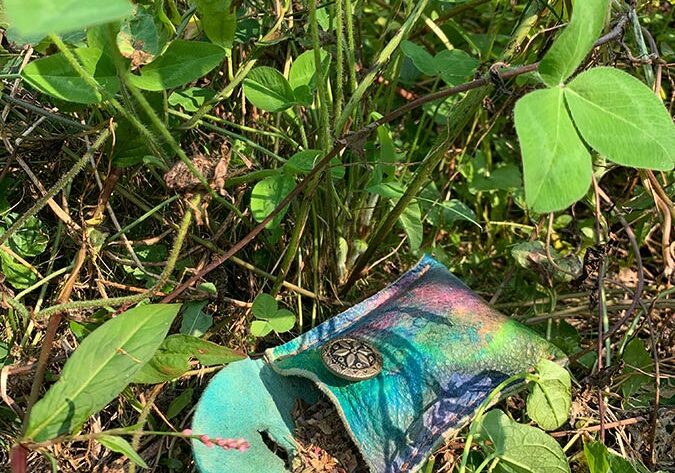
A field of goldenrod, nettle, and aster greet me on this warm post- Fall Equinox day. As the moon comes up with a sliver in the afternoon sky, I joyfully take my basket and harvest knife into the field for my fall plant preparations. The breeze has change in the air–winter is coming soon, and the sacred medicines I prepare will bring my family nourishment and strength for the coming dark half of the year. As we are well into the harvest season at this lovely Fall Equinox, I thought I’d take the time to talk about harvesting and preparation by the sun and moon and honoring the harvest. Next week, I’ll talk about the most basic plant preparations and we’ll end this series with talking about energetic preparations through the creation of flower and leaf essences. That is, we’ll talk about the medicine of both the body and of the soul.
Wheel of the Sun, the Phase of the Moon, and the Turning of the Stars
With working with plant spirits, as we’ve been exploring in this series, we can do everything with sacred intent and awareness that plants aren’t just physical beings. This includes our planting, harvesting, and plant preparations. I have found that when I time my herbal practices by the wheel of the sun (harvesting and planting on sacred days, particularly Beltane, the Summer Solstice, Lughnasadh, the Fall Equinox, and Samhain), these sacred times add a bit of magic to my plant preparations. Further, by working with the plants on these sacred days, I begin building a more rich and full wheel of the year practice focusing on medicine and healing. This means, that, over the years, I have special plants that I harvest at certain times of the year, and part of my celebration of that sacred say includes harvesting plants. Some of these plants, like tobacco, are plants that I grow while others are wild plants that I have cultivated a relationship with over time. For example, Elder is one such plant: the Summer Solstice is “here” for me when the elder is in bloom, and I will often make elderflower cordial on that day to enjoy throughout the year. When the Elder is ripe with fruit, Lughnasadh is here, and I make elderberry elixir for health and healing. These two plant preparations are not only critical to the health of my family throughout the year, but also help me mark and celebrate these holidays with something meaningful. You might select a few plants to cultivate this kind of yearly relationship with.

The phases of the moon offer additional opportunities for sacred timing and herbal preparations. To me, there is little as enjoyable as going out under the full moon or dark moon to create a flower essence. There are two ways to use the phases of the moon: the simple way based only on moon phase, and the more complex way based on what planet astrologically the moon is in at that given time. In terms of moon phases, preparing and harvesting at a new moon or during the waxing moon is good for when you want to bring healing into the body, strengthen the body, or offer nutrients to the body. The full moon brings power to herbal creations and energizes them. A waning moon helps draw out or remove toxins, sickness, or other impurities. If I want to work with removing sickness from the body, perhaps I start with a lunar flower essence of wormwood or walnut, created during the waning moon, and draw upon that energy to help remove sickness.
The turning wheel of the stars combined with the moon phase through astrology offers yet a third possibility for harvesting and herbal preparation. This way is the most in-depth, but also perhaps, most powerful. This way to plant, harvest, and prepare herbal preparations by the phase of the moon is to use astrology, specifically, the moon sign. Each month, the moon spends about two days in each of the 12 astrological signs. The easiest way to know what phase the moon is in is to purchase a biodynamic calendar or a farmer’s almanac; both of these will offer this information. Generally speaking, here is what is important to know:
- Water Signs (Cancer, Pisces, and Scorpio): When the moon is in one of these signs, it is a good time for harvesting leafy, above-ground material for herbal preparations.
- Earth Signs (Taurus, Capricorn, Virgo): When the moon is in one of these signs, it is a good time for harvesting and working with roots (below ground material) for herbal preparations.
- Air signs (Aquarius, Gemini, Libra): When the moon is in one of these signs, it is considered fairly barren and dry. Libra, however, is also associated with flowers, so flower harvests and preparations are appropriate under Libra. Otherwise, these signs should be avoided for plant preparations and harvest.
- Fire Signs (Aries, Leo, Sagittarius): These signs are good “removal” signs, so good for weeding, but not very good for harvest (with the exception of the fourth quarter fire sign, this will be good for preservation). Generally, you want to avoid harvesting under these signs.
These moon phases are fairly complex and can change on a daily basis; what I like about the biodynamic calendar and/or farmer’s almanac is that they spell it out for you on each day (and down to each minute). If you are practicing astrology, you wouldn’t need this kind of tool, but if you aren’t, it is very useful.
These are all tried and true methods for working with plants and also recognizing the many different ways in which sacred timing can be used to increase the potency of the plants. There are many opportunities to choose the timing that best fits your purpose with herbal creations, and doing so adds a layer of sacredness to your actions. Some of these systems may be contradictory (what if the moon is in a fire sign, but it is the Fall Equinox and you want to harvest?) so you need to pick your time and focus on the energy of that particular aspect. I have found that the wheel of the sun has the most power, and if not, I will use a combination of the second two; or work hard to find the perfect moment where all three are in alignment (like 2 days before the fall equinox when the full moon is Taurus for root harvest and preparation!) You don’t always get such amazing timing, but when you can, it makes the event more meaningful.
Honoring Spirit and Harvesting Plants
From an animistic perspective, when you harvest a plant or do any other kind of plant preparation, engaging in respect and honor is part of the necessary work. Part of this is because plants are lending you healing power through its actual body; in the case of root harvests, your harvest may end the life of that plant entirely. I believe that part of the sacred medicine of the plant is built into the relationship that you, as preparer, have with the plant itself. In taking any part of a plant for healing purposes, and asking a plant to work for us, it is only right that we honor the plant spirit as part of our harvest. We can harvest ethically and with sacred intent. So let’s talk about a few ways we might do this:
Honoring the plant. Prior to harvest, make an offering of some kind to the plant. This can be anything simple: a blend of herbs specially prepared (see my tobacco Beltane blend, for example), a song, music, drumming, a dance, a bit of your own liquid gold, a bit of your own energy, a small stone or other tokens. Doing this ensures reciprocation between you and the plant, and lets the plant spirit know that you respect it. I believe this also makes the medicine stronger, as you are building a relationship of respect and mutuality with the plant. You might find, through inner listening, that the plant has a particular kind of offering it wants you to make–and different plants, just like other kinds of people, have a variety of different preferences.

Harvesting for life. Harvest only what you need and think you’ll use. For anything above the ground, harvest parts of plants or plants at the end of their life cycle, taking a small amount. For plants that are abundant, you can harvest more; for plants that are rare, harvest very little (or cultivate them further before harvesting anything at all). If you are doing a root harvest, make sure that your harvest will not damage the larger plant population. I grow or wild cultivate nearly all of the plants I want to do a root harvest from, that way I am in control of exactly how many plants I have planted and how many I am going to harvest. I will not harvest from wild populations unless A) they are extraordinarily abundant and B) I have already worked to spread these populations further. You can also consider doing plant or flower essences for plants that are extremely rare (Indian Ghost Pipe being a good example).
Cultivation and Relationship. Harvest and preparation are not one-shot events but rather, can be lifetime experiences rooted in a practice of nature spirituality. This means that these plants aren’t just a passerby you interact with once in a while, but can be strong plant allies and friends. Recently, I shared a post at Lughnasadh about how to cultivate long-standing relationships with plant spirits. I used sacred tobacco (nicotiana rustica) as my example for this work and offered one strategy to do so. The plant spirit posts I also recently shared offer more tools for this work.
That’s it for this week–during my next post, we’ll get into four different kinds of preparations you can make: drying herbs and teas, tinctures, infused oils and salves, and finally, plant essences.



Reblogged this on Good Witches Homestead.
Thanks for the reblog!
Reblogged this on Paths I Walk.
Thanks for the reblog!
Reblogged this on Blue Dragon Journal.
Thanks for the reblog!
Reblogged this on dreamweaver333.
Thank you for this highly informative post! I have one question: Do you also honor the plants when weeding? I struggle with this aspect of gardening, apologizing to the plants as I pull them out, trying to explain it is for the balance of all who live in my garden, including me. That does not seem like enough, however. Do you have any suggestions for bringing awareness and intention to this part of gardening, without making myself crazy feeling like I am the big, human bully?
Reblogged this on Rattiesforeverworldpresscom.
I find the iLuna app, useful. It sends me a notification each time the moon enters a new sign, and when it is void-of-course. In-app, deeper information is available.
Thanks for the suggestion! 🙂